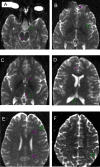Localized 1H-NMR spectroscopy in patients with fibromyalgia: a controlled study of changes in cerebral glutamate/glutamine, inositol, choline, and N-acetylaspartate
- PMID: 20609227
- PMCID: PMC2945024
- DOI: 10.1186/ar3072
Localized 1H-NMR spectroscopy in patients with fibromyalgia: a controlled study of changes in cerebral glutamate/glutamine, inositol, choline, and N-acetylaspartate
Abstract
Introduction: The purpose of this study was to investigate whether single-voxel (SV) proton magnetic resonance spectroscopy (MRS), diffusion-weighted imaging (DWI), and diffusion tensor imaging (DTI) detected differences between fibromyalgia (FM) patients and healthy controls. We also searched for correlations between neuroimaging abnormalities and neuropsychological variables.
Methods: Ten patients with FM and 10 gender- and age-matched control subjects were studied. A neuropsychological examination, DWI, DTI, and proton MRS were performed on the brain areas known to be associated with pain processing.
Results: Compared with healthy controls, FM patients had significantly higher levels of glutamate + glutamine (Glx) (mean ± SD, 10.71 ± 0.50 arbitrary institutional units versus 9.89 ± 1.04; P = 0.049) and higher glutamate + glutamine/creatine (Glx/Cr) ratios (1.90 ± 0.12 versus 1.72 ± 0.23; P = 0.034) in the posterior gyrus. Myoinositol (Ins) levels of the right and left hippocampi were significantly lower in FM patients (4.49 ± 0.74 versus 5.17 ± 0.62; P = 0.008 and 4.91 ± 0.85 versus 6.09 ± 0.78; P = 0.004, respectively). In FM patients, decreased myoinositol/creatine (Ins/Cr) ratios were found in the left sensorimotor area (P = 0.05) and the left hippocampus (P = 0.002) and lower levels of choline (P = 0.019) and N-acetyl aspartate + N-acetyl aspartyl glutamate (NAA + NAG) (P = 0.034) in the left hippocampus. Significant correlations between depression, pain, and global function and the posterior gyrus Glx levels and Glx/Cr ratios were observed.
Conclusions: Glx within the posterior gyrus could be a pathologic factor in FM. Hippocampal dysfunction may be partially responsible for the depressive symptoms of FM. Additional studies with larger samples are required to confirm these preliminary data.
Figures




Comment in
-
Elevated excitatory neurotransmitter levels in the fibromyalgia brain.Arthritis Res Ther. 2010;12(5):141. doi: 10.1186/ar3136. Epub 2010 Oct 1. Arthritis Res Ther. 2010. PMID: 20959024 Free PMC article.
Similar articles
-
Hippocampus dysfunction may explain symptoms of fibromyalgia syndrome. A study with single-voxel magnetic resonance spectroscopy.J Rheumatol. 2008 Jul;35(7):1371-7. Epub 2008 May 15. J Rheumatol. 2008. PMID: 18484688
-
Excitatory and inhibitory brain metabolites as targets of motor cortex transcranial direct current stimulation therapy and predictors of its efficacy in fibromyalgia.Arthritis Rheumatol. 2015 Feb;67(2):576-81. doi: 10.1002/art.38945. Arthritis Rheumatol. 2015. PMID: 25371383 Free PMC article. Clinical Trial.
-
Brain dysfunction in fibromyalgia and somatization disorder using proton magnetic resonance spectroscopy: a controlled study.Acta Psychiatr Scand. 2012 Aug;126(2):115-25. doi: 10.1111/j.1600-0447.2011.01820.x. Epub 2011 Dec 30. Acta Psychiatr Scand. 2012. PMID: 22211322
-
Reduced N-acetylaspartate in the hippocampus in patients with fibromyalgia: a meta-analysis.Psychiatry Res. 2013 Sep 30;213(3):242-8. doi: 10.1016/j.pscychresns.2013.03.008. Epub 2013 Jul 5. Psychiatry Res. 2013. PMID: 23835064
-
Proton magnetic resonance spectroscopy of the human brain in schizophrenia.Rev Neurosci. 2000;11(2-3):147-58. doi: 10.1515/revneuro.2000.11.2-3.147. Rev Neurosci. 2000. PMID: 10718151 Review.
Cited by
-
Neurochemical Correlates of Brain Atrophy in Fibromyalgia Syndrome: A Magnetic Resonance Spectroscopy and Cortical Thickness Study.Brain Sci. 2020 Jun 20;10(6):395. doi: 10.3390/brainsci10060395. Brain Sci. 2020. PMID: 32575715 Free PMC article.
-
Study protocol for a randomised, double-blinded, placebo-controlled phase III trial examining the add-on efficacy, cost-utility and neurobiological effects of low-dose naltrexone (LDN) in patients with fibromyalgia (INNOVA study).BMJ Open. 2022 Jan 6;12(1):e055351. doi: 10.1136/bmjopen-2021-055351. BMJ Open. 2022. PMID: 34992118 Free PMC article.
-
Changes in metabolites in the brain of patients with fibromyalgia after treatment with an NMDA receptor antagonist.Neuroradiol J. 2019 Dec;32(6):408-419. doi: 10.1177/1971400919857544. Epub 2019 Jun 19. Neuroradiol J. 2019. PMID: 31215319 Free PMC article.
-
Changes in metabolites after treatment with memantine in fibromyalgia. A double-blind randomized controlled trial with magnetic resonance spectroscopy with a 6-month follow-up.CNS Neurosci Ther. 2014 Nov;20(11):999-1007. doi: 10.1111/cns.12314. Epub 2014 Sep 17. CNS Neurosci Ther. 2014. PMID: 25230216 Free PMC article. Clinical Trial.
-
Evaluation of the efficacy of memantine in the treatment of fibromyalgia: study protocol for a doubled-blind randomized controlled trial with six-month follow-up.Trials. 2013 Jan 3;14:3. doi: 10.1186/1745-6215-14-3. Trials. 2013. PMID: 23286311 Free PMC article. Clinical Trial.
References
-
- Wolfe F, Smythe HA, Yunus MB, Bennet RM, Bombardier C, Goldenberg DL, Tugwell P, Campbell SM. The American College of Rheumatology 1990 Criteria for the classification of fibromyalgia: Report of the Multicenter Criteria Committee. Arthritis Rheum. 1990;33:160–172. doi: 10.1002/art.1780330203. - DOI - PubMed
-
- Wolfe F. Fibromyalgia, the clinical syndrome. Rheum Dis Clin North Am. 1989;15:1–18. - PubMed
Publication types
MeSH terms
Substances
LinkOut - more resources
Full Text Sources
Medical

